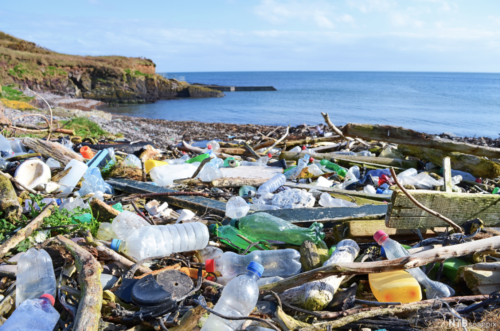Marine plastics. Image courtesy of the Science Photo Library.
Plastic waste has been a visible and growing problem around the world for decades. Various campaigns have been launched by corporations, grassroots organizations, and governments promoting recycling, aimed at reducing our use of single-use plastics and raising awareness on the impact of plastic on the oceans. Single-use plastics are a major source of plastic in the ocean, littering the shorelines of beaches and stretching out across the sea in the Great Pacific Garbage Patch. However, recent research has shown that there is a much more prevalent and invisible threat to the ocean: microplastics.
Microplastics are fragments of plastic smaller than five millimeters long, often created by the weathering of larger pieces of plastic debris. Prior studies have demonstrated that the amount of microplastics in the ocean is much greater than the plastic floating on the ocean’s surface. Recently, professor Andrew Turner at the University of Plymouth has expanded upon these studies and found that paint flakes could be one of the most abundant microplastic particles in the ocean yet.
Turner and his team studied the abundance of microparticles captured by plankton trawls in the North Atlantic Ocean. His team discovered that each cubic meter of seawater could contain approximately 0.01 percent paint flakes. After fibrous microplastics, these paint flakes may be the most abundant source of microplastics in the ocean.
Turner noted that these paint flakes come from boats. Boats are painted with anti-corrosive and antifouling paint that discourages aquatic organisms from attaching to the underwater portion of the boat’s hull. The paint is not only detrimental to marine life, but also more brittle than fibrous plastics. “Paint breaks down more readily than other plastics, and its toxic additives [such as copper and iron] come out more easily. Paints have an additional implication that they are more toxic than an equivalent size of plastic,” Turner said. Thus, it is the abundance, toxicity, and mobility of these paint flakes that warrants closer attention, Turner reasoned.
While there are regulations on the type of paint allowed on boats, many boats still grandfather older, more toxic paints. Furthermore, boats must be painted to prevent damage from marine wildlife. Future steps will likely rely on manufacturers developing less toxic, more degradable paints. Hopefully, with Turner’s new data, more manufacturers and policymakers will be galvanized to come up with better alternatives.
This, of course, does not mean that only boat owners and manufacturers can make a difference. Microplastics that contaminate the ocean come from various sources, ranging from the single-use plastics we consume every day to the fibers from fast fashion clothing. Furthermore, these microplastics are not just confined to the ocean. Microplastics are found in the air we breathe and even the human gut. So, until more degradable types of materials are developed, consumers, manufacturers, and policymakers must all work to reduce plastic consumption as much as possible.

